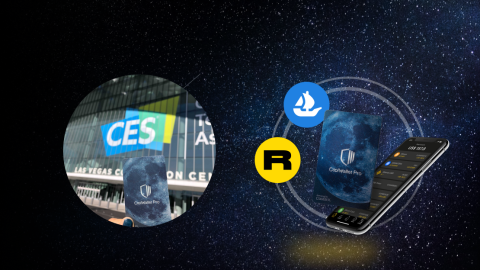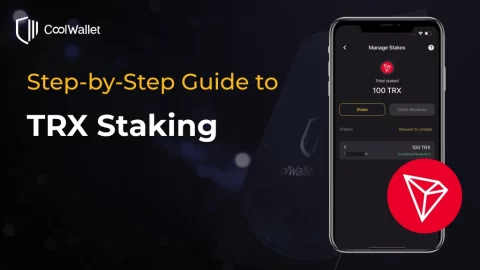This TRON wallet and TRX staking guide explains what TRON is, its history and future (DeFi and NFTs) and how to stake TRX in cold storage on CoolWallet Pro.
Table of Contents
- What is TRON (TRX)?
- How Does TRON (TRX) work?
- TRON Controversies
- Does TRON Use Proof of Stake?
- How Does TRON Staking Work?
- What Are Super Representatives?
- Which TRON Wallet Should I Pick?
- Should I Stake TRON?
- How to Stake TRX on CoolWallet
Introduction to TRON Wallet Staking
TRON is a popular, sometimes controversial platform and cryptocurrency(TRX), that has gone from strength to strength since its launch in 2017 thanks to the support of its diehard evangelists (called the TRX Army) and despite the criticism of hardline detractors. The cryptocurrency has long been held by some users as an alternative to both Bitcoin and Ethereum and been high on the list of CoolWallet assets requested by our community to be supported. Let’s cut through the noise to see exactly what TRON is and how you can earn passive income by staking its native crypto asset TRX on the CoolWallet Pro.
(You can also stake other popular cryptocurrencies like Polkadot (DOT) and Cosmos (ATOM) on our Defi-focused new hardware wallet).
UPDATE: This JUST in! (18 June 2021)
- We’re adding more TRON tokens as promised! Secure your TRC-20 tokens USDT, USDJ, JUST, WBTT, and WINKLink now on CoolWallet Pro while earning TRX staking rewards. Share your TRON questions on social media with us next week (from the 20th June) and we’ll make sure Justin Sun and the Tron Foundation hear them!
- We’re also adding APENFT support soon. Simply make sure you have the token, no need to deposit it into your CoolWallet Pro! Qualify for the airdrop by holding JUST or TRX in your CoolWallet Pro!
What is Tron (TRX)?
Tron is a blockchain-based operating system and platform that aims to “decentralize the web” in its own words by creating a free, worldwide content platform through distributed storage technology and laying the infrastructure for a decentralized internet. It boasts 40 million account holders and 2 million transactions, making it the world’s fastest-growing blockchain, according to its website.
TRON was created in 2017 as an Ethereum-based ERC20 token by Justin Sun, its charismatic and PR-savvy frontman, who frequently hits the headlines due to stunts like his $4.5m auctioned lunch with Warren Buffett. In 2018, the TRX token moved from Ethereum on to its own mainnet. The company also acquired the torrenting program BitTorrent, one of the internet’s largest file-sharing sites.
TRON has made headlines in 2021 thanks to its advances in decentralized finance (DeFi) (through its JUST network) and non-fungible tokens (NFTs) as well as the skyrocketing USDT transaction volume conducted on its network as users switch in droves from Ethereum due to high transaction and gas fees.
How Does TRON Work?
TRON is often described as an “Ethereum-killer”, just like other upcoming smart contract networks like Polkadot, Cardano, and Solana. This is not an unfair assessment since the token shares many of the same features and goals as Ethereum. Both coins are designed as operating systems upon which decentralized applications (DApps) can be based. TRON is powered by the TRX token, which functions as a store of value and as a way to interact with the TRON blockchain.
TRON’s main unique value proposition is its focus on content creators. The original purpose of the platform was to break the stranglehold that a handful of companies have over content creation and distribution, like Youtube. TRON was designed to give creators a way to eliminate the middleman and receive rewards for their content via TRX tokens.
Blockchain and P2P Technology Combined
TRON accomplishes its goals by using features of the blockchain and peer-to-peer (P2P) network technology. Thus, users and content creators can share content without relying on a central content distributor. Content creators can then bypass the middlemen that usually take the lion’s share of the reward, despite their limited contribution. TRON uses distributed storage technology to make this possible.
Additionally, the technology attempts to resolve the problem of “clickbait.” The Odyssey update to the TRON network introduced new incentive mechanisms that rely upon engagement with content and voluntary tipping.
Tron vs Ethereum: Key Points
The foundation of TRON’s smart contract system, called TRX-20, is Ethereum’s Solidity language. This means that TRON smart contracts will be broadly compatible with the Ethereum system and also makes it easier for smart contract developers to use TRON’s network.
The main perceived advantage of TRX-20 over ERC-20 is transaction fees. TRON fees are considered much lower, often nearly zero, whereas Ethereum fees can be as high as $18 per transaction during periods of high network congestion.
Lower fees give TRON some powerful advantages over Ethereum. The most obvious example is an increase in users buying the stablecoin Tether using TRX-20 tokens instead of using ERC-20 tokens. By April, the total volume of Tether stored on the TRON blockchain had hit more than $24 billion, far surpassing the total amount stored on the Ethereum blockchain.
Another potential advantage of TRON is transaction speed. TRON can process around 25,000 transactions per second, compared to Ethereum’s 10-15 transactions per second. This gives TRON better scalability compared to Ethereum.
It is important to note that these advantages might be short-lived. Ethereum is continuing to shift from its bloated Proof-of-Work (PoW)form favoring lucrative ETH mining and transforming through new innovations like its December 2020 Beacon Chain upgrade and July 2021’s controversial EIP-1559 towards its Proof of Stake (PoS) final form and the ambitious Ethereum 2.0 update should theoretically result in reduced transaction costs and increased network scalability. However, TRON has a sizeable lead in both these areas at present.
TRON Controversies

Despite TRON’s success, there have been several controversies since its foundationm. In January 2018, the project was accused of plagiarizing other white papers to write its own. This was explained away as translation difficulties.
Then came the controversies surrounding the project’s founder, Justin Sun. In 2019, Sun announced that he would be giving away $20 million and a Tesla to celebrate the success of BitTorrent. This event was plagued with difficulties, including accusations that Justin Sun had cheated a giveaway winner of his prize with a last-minute change to the draw conditions.
To make matters worse for Sun, some high-profile BitTorrent employees left the company following its acquisition by TRON.
On the other hand, while Sun is equally beloved and loathed by the crypto community, he undoubtedly carries the lion’s share of TRON’s success, tirelessly promoting TRX by announcing new deals and stunts on Twitter, building out new features to prove the naysayers wrong. Sun quickly grasped the importance of living and dying by the sword of social media, becoming a celebrity outlier in an industry where most founders were more technically and less commercially oriented.
In 2017 Sun cleverly used the West’s ignorance about China’s blockchain space to position TRON as the biggest project out of the PRC on the strength of a plagiarized whitepaper and by cranking up the rumor mill through unsubstantiated connections to Alibaba founder Jack Ma as his handpicked protege and the Chinese government. In the process he helped TRON raise a staggering $58 million at ICO and then drove the TRX price through the roof thanks to secretive big announcements and gimmicks like TRON dogs, a copy of Ethereum’s Crypto Kitties. They worked.
There are also concerns that although TRON is openly in favor of decentralization, the company has been copying successful apps onto its network and using its dominant position to outperform them.
Despite these issues, TRON remains healthy and seemingly thrives in the face of controversy. Analysis of on-chain activity reveals a healthy ecosystem. Additionally, TRX is being traded on almost all major exchanges, with the exception of Coinbase. The token is also very appealing for cryptocurrency investors due to the ability to stake TRX and earn rewards (keep reading as we discuss how to stake TRX and claim airdrops further down).
Does TRON Use Proof-of-Stake (PoS)?
Unlike Bitcoin, which came under heavy fire after Elon Musk slammed its energy inefficiency, TRON leverages the Proof-of-Stake protocol. Traditional cryptocurrency transactions are processed by networks of computers solving complicated equations and, in return, they receive cryptocurrency. This practice can cause bottlenecks when the network is under pressure.
It also creates costly transactions as users must pay high “rewards” to secure a place on a miner’s block, potentially undermining its lower per-transaction costs. There have also been reports of environmental damage caused by Proof of Work (PoW).
Rather than relying upon computers to secure the network, individual TRX holders can “lock” a portion of their currency to process a transaction. In exchange for locking their currency, these users are rewarded with some TRX.
How Does TRON Staking Work?
Staking is similar to leaving money in a long-term certificate of deposit and generating interest. The main difference is that it prevents transaction spam which could overwhelm the TRON network.
Like many other cryptocurrencies, there are two ways that users can make money staking, either by running a Super Representative Candidate Node or by voting for a Super Representative.
What Are TRON Super Representatives?
In the TRON network, any account can apply to become a Super Representative and all other accounts can participate in voting on whether an individual should become a Super Representative. The 27 candidates who receive the most votes become Super Representatives and the top 127 receive a reward for participating.
Voting requires TRON Power (TP) which is determined by a user’s staked balance. These Super Representatives decide the exact amount of rewards that TRON stakers will receive for locking their TRX tokens into the network.
Should I Run a Super Representative Candidate Node?
The vast majority of users will probably not want to run a Super Representative Candidate Node. It requires a significant investment in both time and money. TRON’s recommended server settings would cost approximately $40,000 to set up and that cost doesn’t include monthly running charges or the expense of hiring a suitable location.
Additionally, the voting system means that Super Representatives must compete for votes. Campaigning requires community outreach and likely a professional team to ensure you are consistently in the top 27 candidates and can make the most of your equipment investment.
This prospect is out of reach for most users, who will instead want to stake their TRON and vote for a Super Representative. The easiest way to stake is by using a TRON-compatible cryptocurrency wallet that allows easy staking, such as, you guessed it, the sleek new CoolWallet Pro.
Which TRON (TRX) Wallet Should I Pick?
Picking the right cryptocurrency wallet is the most important decision that any TRON investor will make. As with other cryptocurrencies, there are three main varieties of wallets that can be utilized: hardware wallets, software wallets, and exchange wallets. All of these wallets can stake TRON but come with advantages and disadvantages.
Hardware Wallets
Hardware wallets are physical devices designed to store your cryptocurrency completely offline with additional security measures such as biometric verification and secure elements (SE). These devices are considered the most secure option for storing your cryptocurrency since moving the coins requires physical access to both the hardware wallet and its paired device (unless of course the recovery seed is somehow exposed). It is also possible to connect these hardware wallets online to enable staking.
Users should be aware that these devices are not perfect. There have been reports of hardware wallets coming preloaded with malware designed to trick you into transferring cryptocurrency into an attacker’s wallet. Additionally, there have been high-profile data breaches, like the 2020 Shopify hack that revealed the details of 20,000 Ledger customers to hackers. In June 2021 it was reported that some users received fake and malware-loaded Ledgers in order to trick them to reveal their recovery seeds. This is one area where the CoolWallet excels, thanks to its tamperproof (and waterproof) patented cold-compression technology and wafer-thin design.
That being said, hardware wallets make an excellent option for users who are willing to fork out a little extra for iron-clad security of your assets. Also, it’s important to note that if you don’t control your keys, it’s not your crypto.
Software Wallets
These are wallets that are stored or accessed by either a smartphone or computer. There are many TRON-compatible software wallets — for example Guarda — which allow users to store, send, and stake cryptocurrencies.
Software wallets are useful because they can be accessed easily and are fairly secure. However, if your software wallet is housed on a device that you use daily, it is open to attacks like malware. These wallets are secured via seed phrases. If your device breaks or is lost you can recover it by using the words given to you at the wallet’s creation. If you lose this phrase you can’t recover your wallet or cryptocurrency so it is important to keep it somewhere safe. The same also applies for hardware wallets and is a core security tenet to understand.
Software wallets may provide an option to stake within the app. This varies from app to app, but the process is normally straightforward and available on your chosen wallet’s website.
Exchange Wallets
The final — and perhaps most controversial — option is to use an exchange wallet to stake. Whenever you purchase TRX it goes into your exchange wallet. It is generally considered best practice to withdraw this balance as soon as possible to a personal wallet, but some people prefer to leave it in the exchange wallet.
It is important to remember that not all exchanges allow TRX staking. The two biggest exchanges that currently offer it are Bitfinex and Binance. These exchanges handle the entire TRX staking process for you and then take a percentage cut of the total value of your stake.
This is probably the easiest way to stake for many users, but the exchange’s fee might be too big for many individuals to accept, and there’s always the risks that centralized platforms carry.
Should I Stake TRON?
If you believe in the TRON project and plan to hold your TRX for long periods, there is no reason you wouldn’t want to stake your tokens. You can then generate passive income while also benefiting from any long-term price increases.
The only downside of staking TRON is that you can’t access your tokens for at least 3 days while you wait. This means that if there is a flash crash, you could find yourself facing bigger losses than if your cryptocurrency was in a liquid wallet. The short window of 3 days limits this risk.
It is important to note that you should ensure that you are assigning your votes to a popular trusted validator. Otherwise, you may earn fewer rewards or even waste your support on a candidate that fails to make it into the top 27.
How to Stake TRON (TRX) on CoolWallet
Of course, for our community and us, there is only one way to stake TRX and that is on the CoolWallet Pro with its enhanced security (such as an EAL6+ secure element) and incredibly easy-to-use staking interface.
Once you have set up your CoolWallet, follow the below steps to start staking TRX (refer to our step-by-step staking guide with photos here if needed) .
1: GO TO STAKING IN YOUR APP
From the Marketplace page of the app, select ‘Staking’
STEP 2: CHOOSE COINS TO STAKE
Now, proceed with the next steps:
- Select the amount of TRX coins you would like to stake (you can then view the estimated APY, or Annual Percentage Yield, which reflects the real return on investment by adding compound interest). The TRX APY is variable so it’s important to check up-to-date staking rewards.
- Press ‘Stake’
STEP 3: VERIFY WITH CARD
Next, you will need to complete a series of card verification steps in order to complete the staking process. Please review the details of your stake and press ‘Verify with card’ to proceed to the next step.
You will then be prompted to turn on your wallet. Please ensure that Bluetooth is enabled on your phone and press the wallet button until you see the “Hello” message.
STEP 4: CONFIRM THE STAKE
Staking Wallet Confirmation. Once you have paired your wallet with the app, you will need to press the wallet button to confirm the stake:
Confirmations:
- Coin type
- Transaction type
- Staking address (optional, you need to turn on the “Show Full Address” feature in the Settings page of the app)
- Stake amount
*The staking address will be split into 5 segments. Once you have confirmed each segment, please press the wallet button to jump to the next segment. The confirmation may take a few minutes.
STEP 5: VIEW DETAILS ABOUT COMPLETED STAKE
Once you have confirmed the stake amount and the authorization for the Staking Validator’s address, you will see the “Stake Completed” message.
You can then press ‘Staking Management’ to see more details about the stake.
For more on how to claim stake rewards and Unstake, take a look at our comprehensive step-by-step guide.
Should I stake Tron (TRX)?
TRON is certainly a controversial token, even by cryptocurrency standards. However, the idea behind TRON and its technology is still solid and it can no longer be argued that TRX is vaporware with no merit.
If a world where content can be shared freely appeals to you, TRON may be a good bet, especially when considering its loyal TRX Army, PoS credentials, new innovations in DeFi and NFTS, and of course, that sweet sweet staking of TRX on our CoolWallet Pro that will help you accumulate more simply by holding and locking up your TRON.



